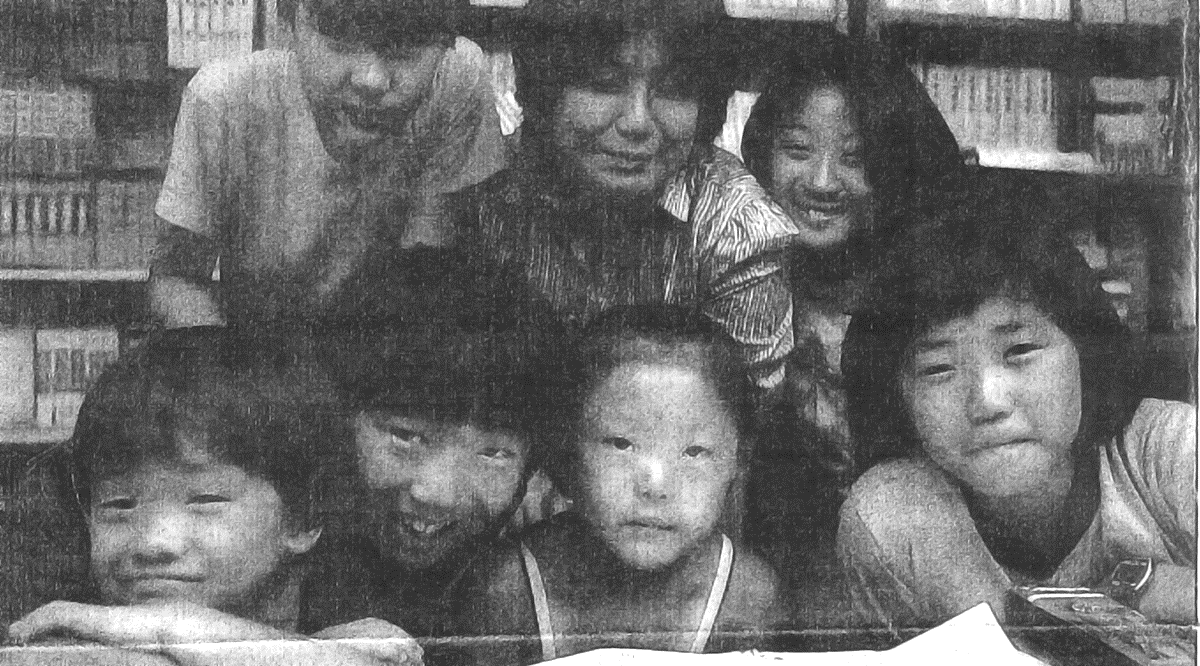
Photo by: Don Jacobsen, Newsday, August 28, 1983; Queens Library, NYC
Published in 1983 by Newsday in a feature story titled, “The Koreans: Making a New Life in New York,” the photograph shows Korean children and their English teacher at a “hakwon” or Korean “cram school” in Flushing, Queens, New York.[1] An educational institution adopted from South Korea, hakwons became established sites of learning in the Korean immigrant community in Flushing after 1965 to boost instruction and achievement for Korean children enrolled in the New York City public schools. Koreans’ enthusiastic support of hakwons in Flushing fit squarely within the framework of that community’s reach as newcomers to the United States for social and economic mobility.
The Newsday article continues with a discussion of the challenges Korean immigrants faced in relocating and settling in the city. In the face of those challenges, it points to the ways in which a developing Korean enclave solidified a sense of community with the establishment of ethnic churches, businesses, social service agencies, and educational institutions, following a boom in Korean immigration to New York City after 1965.
Prior to 1965, the total number of Koreans in the United States was estimated to be fewer than 50,000. The majority were the wives of servicemen, orphans from the Korean War, and students studying on temporary visas.[2] After the passage of the Hart-Cellar Act of 1965, the number of Koreans entering the United States increased annually, reaching 30,000 by 1976. That number was maintained or exceeded annually until 1990, making South Korea the “third largest source country of immigrants to the United States.”[3] Drawn to the United States for better economic and educational opportunities for their children, the majority of Korean immigrants settled in either Los Angeles or New York City. In New York, the borough of Queens, particularly its Flushing neighborhood, attracted approximately 70 percent of the city’s Korean population, radically changing the demographics of the area from a predominantly white area to an ethnic enclave.[4]
The growth of the Flushing enclave was spurred by a high percentage of Korean-owned businesses. While over 40 percent of Korean immigrants entering the United States after 1965 were college-educated professionals or held managerial positions in South Korea, many could not overcome language barriers and discrimination upon their arrival in the United States. Facing difficulties in securing jobs, Korean immigrants in New York City turned toward self-employment in the 1970s, buying produce stores and dry cleaning businesses from Jewish and Italian-American owners, and opening up nail salons, restaurants, and bakeries in Queens and Manhattan.[5]
In addition to the growth of Korean owned stores and shops, Flushing’s emerging Koreatown became the center of strong ethnic networks sustained by churches and the media, including newspapers and radio and television broadcasts. These networks promoted cultural unity and preserved cultural traditions and too became sources of support and means for the exchange of information for Korean parents about everything from childcare to college preparation to the neighborhood hakwon.
A strong emphasis rooted in Korean culture on education as a means of social and economic mobility supported Korean parents’ insistent drive to provide extra instruction for their children outside of the public school. Parents enrolled their children in hakwons, which operating as extracurricular private tutoring academies, emphasized techniques and strategies to boost scores in school subjects and standardized examinations. In sessions after-school, on weekends, and over summer vacations, hakwons, which proliferated in Queens in the 1980s, specifically provided test preparation for admission into one of New York’s specialized high schools. In response to the school system’s test-based policies, Koreans looked to a familiar institution from their native country to give their children a competitive edge in the high school admission process. A means toward successful entry into an elite high school, Korean parents considered their children’s enrollment in hakwons as a necessary first step along the road to admission to an elite college or university and, in turn, toward the development of a successful career trajectory.[6] In sum, hakwons were institutions that embodied and emboldened the belief in meritocracy among members of the Korean-American community. Education and social mobility were viewed by the community as directly correlated, and hakwons in Flushing, Queens, were uniquely positioned to promise success in both.
[1] Jeff Coplon, “The Koreans: Making a New Life in New York,” Newsday. August 28, 1983, Archives at Queens Library, Queens, New York.